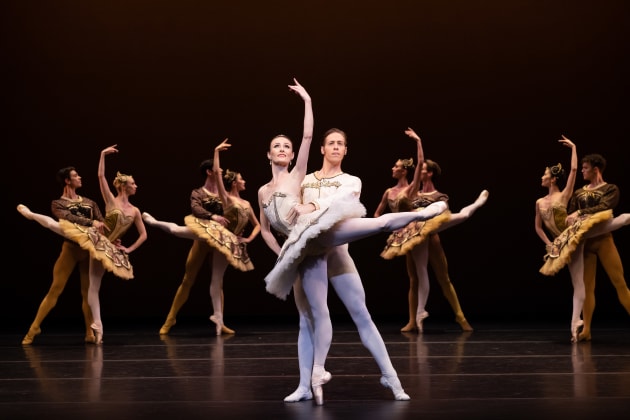Joan Sutherland Theatre, Sydney Opera House
Reviewed April 27
What a refreshing selection of classical and modern ballet there was to enjoy in the Australian Ballet’s "Counterpointe" program. The selected works were presented in chronological order of their creation, with Act III of Raymonda up first. This is artistic director David Hallberg’s new staging, re-using costumes originally designed for a 1998 production of Balanchine’s Theme and Variations by Hugh Colman. These costumes of cream and gold, with fine black trim, create an opulent yet pared back aesthetic which allows the classical shapes and forms of Petipa’s late 19th century choreography to really project across to the audience. The set design was minimal - just one central chandelier and fringed curtains either side - but Jon Buswell’s golden-hued lighting design gave a pleasingly warm glow to the surrounding stage space, costumes and the dancers themselves.
In the leading role of Raymonda, Amber Scott impressed with her musically accurate and nuanced performance. She displayed sure technique and a confident authority, while still leaving space for more dramatic and lyrically expressive highlights at certain points within the dance. Ty King-Wall made a considerate and attentive partner in the role of Jean de Brienne but was less impressive in his own solos which were marred by seemingly "heavy" landings. Sharni Spencer sparkled in a solo which required fast footwork and attack, but sadly… Act III was all over too soon. Could we see a full-length traditional Raymonda from the Australian Ballet in the near future I wonder….?

George Balanchine’s Tchaikovsky Pas de deux was danced with breathtaking skill, joy and abandon by Ako Kondo and Chengwu Guo. Anyone who has seen these two dancers on stage previously knows how technically strong and virtuosic they are, but what impressed on this opening night was their shared willingness to take risks - really pushing the envelope in terms of speed, dynamic range and power. When Kondo performed a series of chaine turns into the wings, she actually increased her already dizzyingly fast speed in the last few seconds before disappearing offstage. And although there were a few moments where that incredible force almost took the pair off balance and made a clean finish appear to be a matter of chance rather than a predictable eventuality, the same force was simultaneously a key factor driving the excitement felt palpably across the auditorium during their performance.
The program finished with Artifact Suite, a shorter version of the four-act ballet Artifact, created by William Forsythe in 1984. With a cast of close to 40 dancers, this work impressed for the sinuous synchronicity of the large ensemble sections. Interestingly, the relatively small opera house stage looked surprisingly vast, perhaps because of its exposed depth and/or because the horizontally angled lighting from the wings created the illusion of more width just out of sight. Choreography, staging, costume and lighting design for this work are all attributed to William Forsythe, and while I don’t find Artifact Suite as exciting to watch as his In the Middle, Somewhat Elevated, it does provide an interesting stylistic contrast to the earlier works in the program. As part of this work the fire curtain comes down with a thump on numerous occasions - but never stays down for long. In abruptly cutting off the audience’s view of the dancers, this tactic forces those of us in the audience to constantly reframe our view of the work and introduces a seemingly unpredictable and random element which is entirely congruent with the way Forsythe distorts and extends the technique of classical dance through his choreography.
There was an enjoyable range of music throughout Counterpointe, from composers Glazunov (Raymonda) and Tchaikovsky to J.S. Bach and Eva Crossman-Hecht (Artifact Suite). Congratulations to the Opera Australia Orchestra under the baton of Nicolette Fraillon, who bring so much added value to live ballet performances at the Sydney Opera House.
- GERALDINE HIGGINSON
Sign up to our e-news here. It's free!







